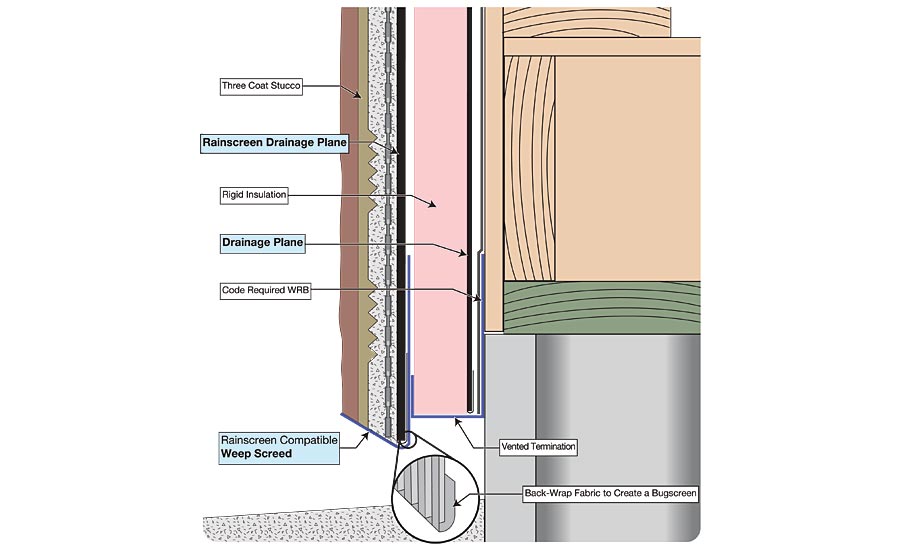Room to Breathe: EIFS, Stucco & Thin Stone
Ounce of prevention is worth a pound of cure.

Insulation board didn’t keep all the moisture out–neither did the housewrap. Photo Credit: Mark Parlee, The Building Consultant.

EIFS manufacturers recognize the importance of drainage behind insulation board (note the drainage strip and vertical strips of adhesive). Photo courtesy of Dryvit.


Traditional Weep Screed:
Where’s the drainage on a traditional weep screed? Not the holes.
Source: Paddy Morrissey, Code Check Building 2nd Edition.


Belt and suspenders approach to detailing: drain moisture on both sides of the rigid insulation.






The historical mudslinging (pun intended) between proponents of traditional stucco clad walls and modern EIFS continues as both sides compete to be spec’d in projects small and large. When well designed and executed by skilled tradespeople, both systems perform well and provide an appealing appearance. Executing the details correctly in modern stucco and thin stone wall assemblies with outboard rigid insulation draws many parallels in details with their EIFS counterparts.
Customer demand for the traditional masonry look persists, but demand for better building performance has changed many of the subsurface components, sometimes with unintended side effects. Air sealing, increased insulation (including continuous insulation), vapor control layers and the use of OSB aka oriented strand board have all made a substantial impact on the building enclosure. The introduction of any one of these components is cause to re-evaluate the performance of the entire wall assembly.
Each of these changes to wall assemblies has reduced energy flow across the wall. Air, temperature and vapor flow played a significant role in drying out moisture. Leaky old buildings dried out and we didn’t experience the same moisture-related wall failures as we see today. Remediating moisture problems is a $1 billion annual industry. Many national homebuilders even publicize contacts for their dedicated representatives to address moisture intrusion. Ask anyone that’s lived through moisture problems—owners, contractors and architects—it’s a painful and litigious process. We’ve got the tools to significantly reduce those failures; now we need to resolve how to do something about it.
Debunking Moisture Myths
Myth 1. It takes a lot of water to cause moisture problems
Reality: The recipe for disaster is water plus time. A little moisture can do a lot of damage when it can’t dry out and each of those modern control layers mentioned reduces that ability to dry out. Older walls got wetter, but dried out faster and had fewer problems. Modern materials are more moisture sensitive (think OSB) and can’t dry out quickly, resulting in mold, rot and failure.
Myth 2. “Better” WRBs keep walls drier
Reality: Over reliance on weather resistance barriers have contributed to moisture problems. The performance of any WRB is improved when it is separated from the exterior by a rainscreen air gap. A predictable separation of at least 1/8 inch creates a capillary break so that gravity can drain the moisture. Without the gap, capillary rise moves water upward in the wall, and it finds its way to imperfections and penetrations in the WRB. A predictable and continuous air gap results in greater draining and drying potential.
Myth 3. Weep screeds “weep”
Reality: In a rainscreen wall assembly, an air gap of at least 1/8-inch drains and ventilates the wall. Logically, the terminations should have the capacity to drain this water, but most weep screeds lack this capacity. Most common weep screeds feature small holes but they aren’t for weeping—rather they are for “attachment” and rely on a shrinkage crack between the stucco and the weep screed to drain the wall. Rainscreen-compatible weep screeds feature large slots for drainage and ventilation below the air gap.
Myth 4. Walls Need a Vapor Barrier
Reality: Vapor can be controlled without stopping it altogether—issues arise when multiple layers function as vapor barriers and trap moisture between them. Solar vapor drive is a real concern when using reservoir claddings like stucco and thin stone over gypsum, OSB or plywood sheathing. The WRB frequently performs dual roles as a water and vapor control layer. Building Science Corp recommends a vapor control layer (likely your WRB) over the gypsum, OSB or plywood sheathing with a rating of 10-20 perms, along with a predictable rainscreen air gap.
Good detailing and execution is as important as the quality of products used. That detailing means that water, air, thermal and vapor control layers should be continuous. Pesky penetrations (windows, doors, etc.) make continuity challenging—any interruption to rainscreen drainage planes must drain liquid water away from the building façade.
Field studies have shown that ventilated rainscreen walls (where the rainscreen air gap can vent at the bottom and top of the assembly) dry out faster and perform better. See detail 1 for venting the stucco or thin stone rainscreen. At bottom terminations in stucco and thin stone walls, choose a rainscreen-compatible weep screed with large slots designed for drainage and ventilation.
Continuous Insulation: Stucco & EIFS
Continuous insulation’s advantages in thermal performance come with confusion on detailing with rigid foam. The big question to address is, “which layer is the drainage plane/WRB?” The response is often that the foam is the WRB … but so is the housewrap, which is sometimes under the foam, other times over the foam and sometimes both. Which of those layers are you flashing to? Where will moisture from the interior potentially condense? Is foam insulation a sufficient barrier on its own? Confused yet?
Not all foams are created equal: many newer formulations are more dimensionally stable than the foam of thirty years ago. Some qualify as a WRB when detailed correctly, others do not. The EIFS industry recognized that foam was not a perfect barrier system, and the solution was to create a drainage gap between the foam and the water resistive barrier. But won’t that gap degrade the R-value of the assembly? The magic number is 1/8 inch. An air gap of 1/8 inch drains liquid water by creating a capillary break and limits thermal loss to around five percent, which is the same as thermal bridging from attaching the foam.
Stucco and thin stone with continuous rigid insulation should take cues from EIFS—having an air gap to drain behind the rigid insulation is important, as moisture could potentially migrate there from the interior (as vapor) or from the exterior (in liquid or vapor form). A second draining layer immediately behind the stucco and thin stone is advantageous as well to quickly and evenly dry the stucco, reducing efflorescence and cracking.
Our industry is often resistant to change—being open to improved air sealing, insulation and moisture control are positive steps for everyone involved. But when sailing on an “unsinkable” ship it is wise to count the lifeboats. We know that “perfect” barriers are imperfect and they don’t have to be perfect to perform well. In terms of moisture, having capacity to drain and dry with a predictable air gap is the key.
Looking for a reprint of this article?
From high-res PDFs to custom plaques, order your copy today!











